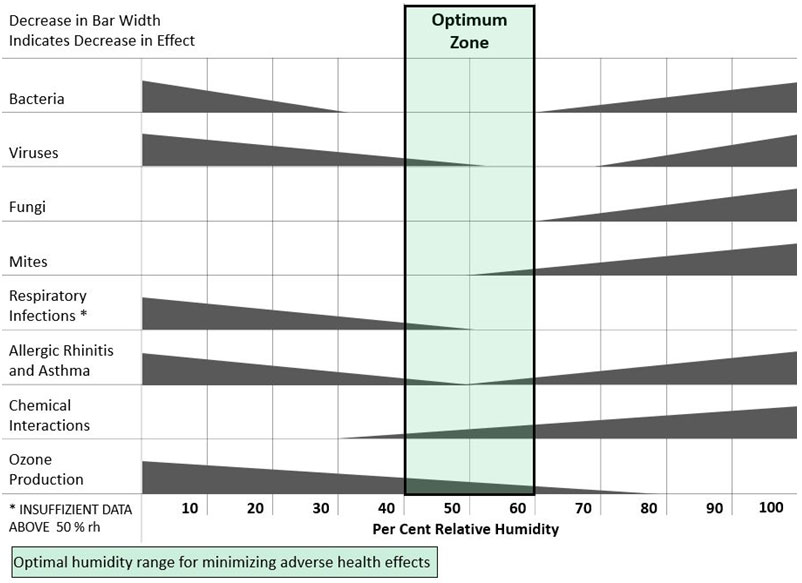How much time is spent indoors ? Around 90% of our life!
You can therefore imagine how important it is that the air we breathe everyday is of good quality. A lot of studies are made to provide the optimal ventilation, freshness of air, indoor pollution, cleanliness and the list goes on!

We will be taking a closer look into Indoor air humidity and how it influences our Indoor air quality (IAQ), but first let us define air humidity and IAQ.
According to wikipedia:
Humidity is the amount of water vapor in the air. If there is a lot of water vapor in the air, the humidity will be high.
According to the international society of indoor air quality (ISIAQ):
[Indoor air quality is] an indicator of the types of pollutants in the air that might cause discomfort or risk of adverse effects on human or animal health or damage to vegetation.
To continue we will help ourselves with a psychrometric chart.

This graph describes the thermodynamic properties of the air. It is actually very easy to use. To define a point, you only need two parameters and from there you can obtain all other quantities, such as relative humidity, dry bulb temperature, enthalpy, etc…
Thanks to this psychometric we can easily identify the area of thermal comfort (the green area), the relative humidity (RH) and the dry bulb temperature of our environment to stay within that section.
Humidity perception
The perception of the impact of RH on IAQ can be experienced through sensory irritation and effects on health.
When RH is low, there is an overall feeling of “dry air” which is correlated with eye irritation and symptoms and increased respiratory problems, the typical sick-building syndrome. [2]
Higher humidity also gives the impression of “stuffy air” and increases the perception of odors and dustiness. In such environments, undesirable mold growth is promoted, which could trigger human responses or even damage the indoor furniture and walls in the long term.[2]
Therefore it is suggested that the RH must stay inside the 40-60% range.

Both temperature and humidity have effects on the cooling of the respiratory tract as they change the energy content of the air we breathe in. According to Fang, Clausen, and Fanger, 1998 :
The more cooling the respiratory tract was exposed to, the fresher and more acceptable was the air perceived. An insufficient cooling may be interpreted as a local warm discomfort in the respiratory tract and lead to the inhaled air being perceived as unacceptable. [1]
Warmer and more humid air is felt as a local warm discomfort in the respiratory tract, which makes most people conclude the air is unacceptable.
How is it in Switzerland ?
Since we live in Switzerland it’s interesting to explore our own country’s situation on air humidity and indoor air quality. Overall studies seem to agree that on average the swiss are satisfied with the air quality in their living spaces.
According to some data collected for the Baudirektion Kanton Zürich, In northern Switzerland the average air humidity changes between homes without ventilation (42% RH), with ventilation (35% RH) and with both ventilation and humidity control (39% RH). If you look at the pattern between the living spaces with and without ventilation you can see that non ventilated places, with higher humidity, had more potentially harmful organic matter in the air (Table 1). The places with ventilation and humidity regulation had the “cleanest” air with more human satisfaction. [3]
|
Average amounts |
||||
Ventilation |
Relative (%) |
Air (°C) |
Concentration |
Concentration of |
No
|
42
|
23.1
|
180
|
950
|
with
|
35
|
23.7
|
150
|
1000
|
with
|
39
|
23.4
|
130
|
800
|
In Swiss homes it’s interesting to consider how hardwood floor influences and is influenced by RH. As wood is a hygroscopic material, it absorbs water present in the air and thus affects the RH in a room. It has also been researched that not only do large RH fluctuations in the home affect human health but they also damage the hardwood floor.[3]
However, even with a mechanised ventilation system what influenced the RH the most was the user decision of opening windows. Overall, although there is no formal swiss lower and upper accepted bound of RH, it is recommended by swiss experts that in winter it should not drop lower than 30%. (As no study has been conducted for the whole country with a large enough data pool, this is only a generalisation). [3]
What can we do to improve air humidity ?

Excessive air humidity is often the result of poor ventilation as well as indoor sources of humidity, such as drying clothes inside, or cooking for example. Frequent ventilation (as simple as opening windows) is primordial. This can also be achieved by the use of ventilation tools, such as the exhaust hood in a kitchen, or mechanical ventilation in a bathroom for example. Water infiltrations from the roof or brickworks should be monitored too. In addition, preventing condensation on cold surfaces, for example through the use of storm windows and double glazing over the windows during the winter, or covering over water pipes. Finally, dehumidifiers as well as Air Conditioning (ACs) can also be used, although they can release biological pollutants if not properly maintained. [4]
If you have doubts over the humidity levels in a space, sensors are widely availables and relatively cheap. IoT devices are also very present on the market. These will allow you to take objective measures, and not rely on a subjective impression. Building contractors can also give you professional advice. [4]
In the case of low humidity levels, it is quite easier to solve. Easy ways to increase humidity levels in the house include air-drying clothes inside, boiling water, leaving doors open after a shower to allow humidity to move around or adopting a plant pot, as they release moisture. If the problem becomes persistent, using a humidifier or air conditioner is possible, although carefulness is advised in order to avoid creating the inverse problem. Again, seeking professional advice is always a good idea before taking such steps. [5]

Well this is it for now. I hope you feel more informed and comfortable about the link between air humidity and indoor air quality. As you’ve read, improving your indoor air quality isn’t that hard, everybody can do it!
Denise Vandeuren, Neroli Soso, Angelika Atienza, Julien Ars
References
In addition to the CIVIL-212 class material :
[1] Fang, Clausen, and Fanger, “Impact of Temperature and Humidity on the Perception of Indoor Air Quality.”, 1998. Link.
[2] Wolkoff, “Indoor air humidity, air quality, and health – An overview”, 2018. Link.
[3] Budesamt für Gesundheit (BAG), “Schlussbericht Raumluftfeutchte in Wohnneubauten” (PDF, 2016)
[4] United States Environmental Protection Agency (EPA), “What are the main ways to control moisture in your home?” (Web, visited on 20.11.2020)
[5] Marie Bannister, “How humidity damages your home — and how to fight it” (Web, visited on 20.11.2020)